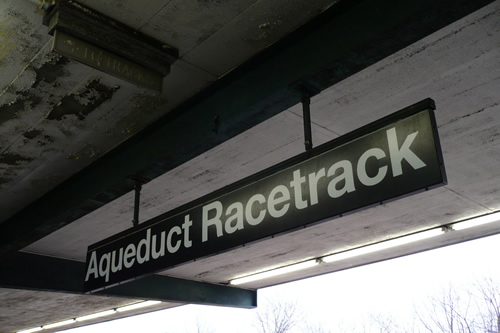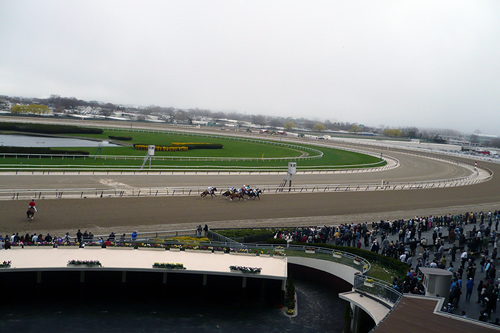Aqueduct
Last weekend, I visited Aqueduct for the first time since leaving New York City back in 2010, and I wasn’t sure what to expect. Jerry Bossert reported abysmal conditions at the track earlier this year. NYRA board members complained about grime and birds in the Equestris buffet. Even though Left at the Gate defended the place, with photos that made it look pretty good, I still wondered if I might find a crumbling, neglected clubhouse filled with flocks of pigeon toughs menacing degenerates for their hot dogs, the decay and disorder made all the more pronounced by the gleaming casino floor a short walk away.
But the track was actually in much better shape than I remembered or anticipated, a happy surprise, and mostly clean.* The new Longshots bar and simulcasting center was open and bustling on Saturday, the fresh paint throughout was nice, and the Aqueduct Murals were a real delight:





*The exception was the unrenovated second floor outdoor seating, where fans were crammed into the last section past the finish line. Trash strewn, unpleasant, and with poor sightlines to the paddock and track, it was just a downer spending any time out there. I was disappointed to realize it and the apron are now the only accessible outdoor space. (So, views like this from my old favorite spot in the third floor box seat area are no more.)
– – – – –
With Wicked Strong’s Wood win, Boston gets a Kentucky Derby connection. The colt, named in honor of the community spirit that pervaded the city after the 2013 Boston Marathon attack, runs for Massachusetts-based Centennial Farms, and a portion of his earnings go to The One Fund. He earned a Beyer speed figure of 104 for the Wood, a new career high by 17 points. TimeformUS also gave him a new career topper of 117, 25 points above his previous best on their scale, and four points higher than what they gave California Chrome for winning the Santa Anita Derby. He was given a Beyer of 107 for his victory in that race. Charts and replays for both, and the updated Kentucky Derby leaderboard, are available via the 2014 prep schedule spreadsheet.
… for the crumbling, charmless Aqueduct Racetrack subway stop, set to close on Saturday in advance of renovation for anticipated casino patrons.

The old station won’t be missed, but I get a real pang looking at pictures of the demolished outdoor grandstand seating and thinking about the loss of the unobstructed view afforded by the third floor seats overlooking the finish line.

The field for the 2010 Wood heading into the clubhouse turn.
4/8/11 Addendum: Week-by-week photos of the construction work at Aqueduct by Brooklyn Backstretch. Stunning, how much demolition is involved.
Aqueduct numbers year-to-year, week-to-week, and day-to-day:
On the second day without NYC OTB, on-track attendance was still up, and on-track handle spiked by almost 11% over Wednesday, 12.8% over the previous Thursday. Interstate handle declined from the day before, but was up a tiny 1.3% over last Thursday. The ugly number is intrastate handle, which was down 4.6% over Wednesday, and almost 39.1% from last Thursday. How much of that was money moving? The difference in on-track handle from Wednesday to Thursday is plus $53,125; intrastate handle minus $40,000. If most of the upped on-track dollars were formerly intrastate wagers, then NYRA made gains, even if small. Over on LATG, Alan Mann estimates that NYRA needs to “capture one-third of the wagers placed on its races at NYC OTB in order to break even,”* and it does seem as though they’re doing all they can to grab those bettors, if the flurry of press releases sent out today is any indication, offering double points to customers signing up for NYRA Rewards before December 31, opening up Belmont for simulcasting beginning this Sunday, and looking for a way to get the races back on TV in the city.
In a comment yesterday, EJXD2 said, “I wish people would stop lamenting the death of NYC OTB and instead celebrate that a corrupt system is no more.” Fair enough. Huzzah! NYC OTB is dead! But there’s not much time for lamenting or celebrating. John Pricci called December 7, “the beginning of the end of the modern era of racing in New York,” and while we may not look back on that as such a bad thing, given how troubled the era passing became in its latter days, there’s pain ahead due to lost livelihoods and inevitable structural changes. The bright side (really) is now that closure has come to pass, and action is necessary before the whole industry goes broke, New York has an opportunity to blow up the dysfunctional OTB system and replace it with a streamlined operation** better suited to supporting racing in the contemporary market, which means efficient management and an approach to customers that’s less get-your-fix and more have-great-fun. It won’t be easy, but it must be done.
*8:15 PM Update: Talking to reporters in the Aqueduct press box this morning, NYRA CEO Charles Hayward confirmed that’s about right: “Hayward estimated that NYRA has to try and make up for 35 percent of what NYCOTB handled at its parlors because only 2.4 percent of each dollar wagered at an OTB parlor goes to NYRA, compared with 10 percent of each dollar wagered ontrack.”
**12/10/10 Update: Writes Jerry Bossert in the NY Daily News: “I’m all for it, but it will never happen as there would then be only one President, one vice-president, one director of marketing, etc. It will never fly as there are too many patronage jobs out there currently occupying all those seats in the other five regions.” I fear he’s right — political considerations have held up past attempts at reform — but maybe NYC OTB closing was just the shock needed to make this time different. (Via @BklynBckstretch.)
Copyright © 2000-2023 by Jessica Chapel. All rights reserved.